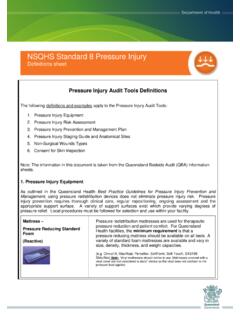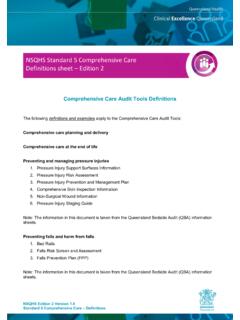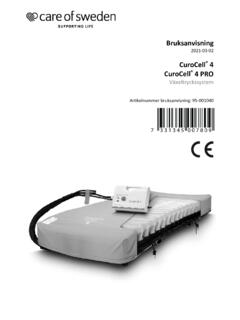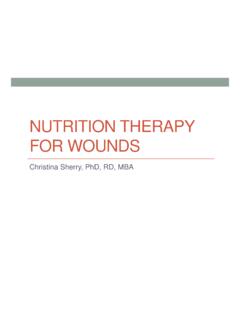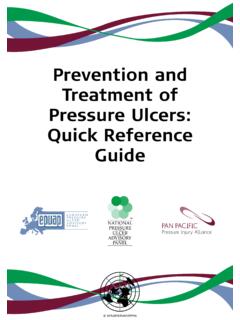Transcription of Prevention and Treatment of Pressure Ulcers/Injuries
1 PAN PACIFICP ressure Injury AlliancePrevention and Treatment of Pressure Ulcers/Injuries :Quick Reference Guide2019 Copyright European Pressure Ulcer Advisory Panel, National Pressure Injury Advisory Panel and Pan pacific Pressure Injury AllianceISBN 978-0-6480097-9-5 First published 2009 Second edition published 2014 Third edition published 2019 Published by European Pressure Ulcer Advisory Panel, National Pressure Injury Advisory Panel and Pan pacific Pressure Injury AllianceAll rights reserved. Apart from any fair dealing for the purposes of private study, research or review, as permitted under the Copyright Act, no part may be reproduced or copied in any form or by any means without written permission. Requests to reproduce information can be emailed to citation:European Pressure Ulcer Advisory Panel, National Pressure Injury Advisory Panel and Pan pacific Pressure Injury Alliance. Prevention and Treatment of Pressure Ulcers/Injuries : Quick Reference Guide.
2 Emily Haesler (Ed.). EPUAP/NPIAP/PPPIA: :This quick reference guide was developed by the European Pressure Ulcer Advisory Panel, the National Pressure Injury Advisory Panel, and the Pan pacific Pressure Injury Alliance. It presents a comprehensive review and appraisal of the best available evidence at the time of literature search related to the assessment, diagnosis, Prevention and Treatment of Pressure injuries. The recommendations are a general guide to appropriate clinical practice, to be implemented by qualified health professionals subject to their clinical judgment of each individual case and in consideration of the patient consumer s personal preferences and available resources. The guide should be implemented in a culturally aware and respectful manner in accordance with the principles of protection, participation and partnership. Review the full clinical Practice Guideline for further context and copies of the English version of this quick reference guide can be ordered, and PDFs downloaded, from the following websites:NPIAP Guideline PACIFICP ressure Injury AllianceTABLE OF CONTENTS1 Introduction Foreword.
3 2 Limitations and Appropriate Use of this Guideline ..3 Strengths of Evidence and Strengths of Guideline Recommendations and Good Practice Statements ..5 Accessing the Guideline and Support Material ..62 Guideline Developers ..73 Acknowledgements ..114 Sponsor Acknowledgements ..135 Recommendations and Good Practice Statements ..14 Risk Factors and Risk Assessment ..14 Skin and Tissue Assessment ..16 Preventive Skin Care ..17 Nutrition Assessment and Treatment ..18 Repositioning and Early Mobilization ..20 Heel Pressure Injuries ..22 Support Surfaces ..22 Device Related Pressure Injuries ..25 Classification of Pressure Injuries ..26 Assessment of Pressure Injuries and Monitoring of Healing ..27 Pain Assessment and Treatment ..27 Cleansing and Debridement ..28 Infection and Biofilms ..29 Wound Dressings ..31 Biological Dressings ..32 Growth Factors ..33 Biophysical Agents ..33 Pressure Injury Surgery ..33 Measuring Pressure Injury Prevalence and Incidence.
4 35 Implementing Best Practice in clinical Professional Education ..36 Quality of life, Self-care and Education ..366 Quality Indicators ..377 Commonly Used Classification Systems ..382 QUICK REFERENCE GUIDE ABRIDGED GUIDELINEINTRODUCTIONF orewordThis Quick Reference Guide presents a summary of the recommendations and good practice statements contained in the full guideline, the International clinical Practice Guideline (2019 edition). The more comprehensive clinical Practice Guideline provides a detailed analysis of the evidence underpinning the recommendations and good practice statements and includes important implementation considerations that provide further context to the statements included in the Quick Reference Guide. This Quick Reference Guide is intended for busy health professionals who require a quick reference in the clinical setting. Users should not rely on excerpts from the Quick Reference Guide guideline was developed as a collaboration between the Partner Organizations European Pressure Ulcer Advisory Panel (EPUAP), National Pressure Injury Advisory Panel (NPIAP) and the Pan pacific Pressure Injury Alliance (PPPIA).
5 Additionally, 14 wound organizations from 12 countries joined the project as Associate Organizations contributing to the development, under the direction and oversight of the Partner Organization Guideline Governance Group (GGG) and a methodologist. The full development team consisted of 174 academic and clinical experts in the Pressure injury field, including the 12-member GGG, the methodologist and working group edition of the guideline used the most recent methodological standards in guideline development. The methodology has been pre-published and peer reviewed. An updated literature search identified research published up to August 2018 that was critically appraised and analysed. New research has been combined with research from previous editions to extend the guideline scope and produce recommendations reflecting the most recent evidence. This third edition provides 115 evidence-based recommendations supported by an overview of the underpinning research.
6 Implementation considerations providing practical guidance are provided to assist health professionals to implement the recommendations in clinical practice. A detailed analysis and discussion of available research, and a critical evaluation of the assumptions and knowledge in the field is included to provide further 31 INTRODUCTION context. A consensus voting process was used to assign a strength to each recommendation. The strength of recommendation identifies the importance of the recommendation based on potential to improve patient outcomes. It provides an indication of the confidence one can have that the recommended practice will do more good than harm, and can be used to assist in prioritizing Pressure injury related interventions. Many topics of relevance to Pressure injury Prevention and Treatment have not been researched extensively. To address gaps in care, the GGG has also developed 61 good practice statements intended to further assist health professionals to deliver quality Pressure injury Prevention and of patients, informal caregivers (families and friends) and other stakeholders has been extensive throughout the guideline development.
7 An online survey of patient consumers and informal caregivers was conducted to identify care goals, priorities and education needs. Responses from 1,233 patients and their families from around the world were incorporated into the guideline development. Drafts of the recommendations and supporting evidence were made available to 699 stakeholders (individuals and organizations) around the world who registered and reviewed the documents. Limitations and Appropriate Use of This Guideline guidelines assist health professionals, patient consumers and informal caregivers to make decisions about healthcare for specific clinical conditions. The evidence-based recommendations and good practice statements may not be appropriate for use in all circumstances. The decision to adopt any recommendation must be made by the multidisciplinary healthcare team, in collaboration with patients and informal caregivers, and with consideration of available resources and circumstances.
8 Nothing contained in this guideline replaces medical advice for specific cases. Because of the rigorous methodology used to develop this guideline, the Guideline Governance Group members believe that the research supporting the recommendations is accurate. Every effort has been made to critically appraise the research contained within this document. However, we do not guarantee the reliability of individual studies referenced in this REFERENCE GUIDE ABRIDGED GUIDELINE This guideline is intended for education and information purposes only. This guideline contains information that was accurate at the time of publication. Research and technology change rapidly, and the evidence-based recommendations and good practice statements contained in this guideline may be inconsistent with future advances. The health professional is responsible for maintaining a working knowledge of research and technology advances that may affect their clinical decision making.
9 Generic names of products have been used, with descriptions of products taken from the research. Nothing in this guideline is intended as endorsement of a specific product. Nothing in this guideline is intended as advice regarding credentialing standards, coding standards or reimbursement regulations. The guideline does not seek to provide full safety and usage information for products and devices; however, commonly available safety and usage tips have been included. All products should be used according to manufacturer s of Evidence and Strengths of RecommendationsIndividual studies were assigned a level of evidence based on study design. The body of evidence supporting each recommendation was given a strength of evidence based on evidence quantity, levels and consistency. A consensus voting process was used to assign a strength of recommendation.
10 The strength of recommendation can be used by health professionals to prioritize interventions. Refer to the full clinical Practice Guideline and/or the International Guideline website for explanation and context of the strength of evidence and strength of strength of recommendation is the extent to which a health professional can be confident that adherence to the recommendation will do more good than harm. 51 INTRODUCTIONS trengths of Evidence A More than one high quality Level I study providing direct evidence Consistent body of evidenceB1 Level 1 studies of moderate or low quality providing direct evidence Level 2 studies of high or moderate quality providing direct evidence Most studies have consistent outcomes and inconsistencies can be explainedB2 Level 2 studies of low quality providing direct evidence Level 3 or 4 studies (regardless of quality) providing direct evidence Most studies have consistent outcomes and inconsistencies can be explainedC Level 5 studies (indirect evidence)
